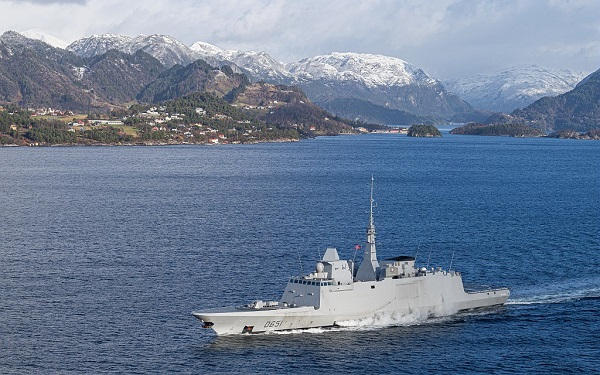
The multi-mission frigate Normandy mock-sinks a German submarine during NATO exercises
On March 3, NATO began in Norway the Northern Response Exercise, involving 20,000 troops, 100 aircraft and about fifty ships, which would allow validation of its new defense plans against Russia in the Far North. It aims to demonstrate that the alliance “clearly possesses the capacity, will and strength to defend its territory and its northern flank,” as the Norwegian Forces General Staff explains.
Given Norway's proximity to the so-called “GIUK” crossing. [Groenland, Royaume-Uni, Islande]It is essential for supply lines between North America and Europe, and Russian submarines are highly active in this region. Anti-submarine warfare is also a component of the North's response.
As part of this exercise, the French Navy deployed an Atlantic II-class maritime patrol aircraft, a multi-mission frigate [FREMM] Normandy, a nuclear attack submarine [SNA] “Amethyst” and a triple-type mine hunter [CMT] Andromeda. Note that a section of Marines from the Demolition Battalion were on board the US amphibious assault ship USS Guston Hall.
In the post 👁
A wonderful sight in the Arctic waters like the French submarine 🇫🇷 Amethyst & the @COMUKCSG They joined forces to raise their sub-zero game during #NorthResponse. ❄️
This chapter of #StandingDefender24 He raises the unity of the allies to unprecedented levels, forming a powerful army… pic.twitter.com/BAftSzBM8t
– strikefornato (@strickfornato) March 11, 2024
While the exact terms of the North's response are unknown, the Associated Press reported However you mentioned That the German Type 212 submarine was given the “attacker” role. He apparently acquitted himself very well because he managed to fakely “torpedo” the Italian aircraft carrier ITS Giuseppe Garibaldi. On the other hand, he did not succeed in surprising the Normandy frigate, commanded by the captain of the frigate [CF] Thomas Fong.
As a matter of fact, the crew of the French frigate was not warned of the attack that the German submarine was preparing to launch. However, this one, though appreciated [le Type 212 passe pour être très silencieux…] He did not escape his vigilance. “We spotted his binoculars […] Then he dived back in,” CF Vuong said.
The NH-90 Caïman helicopter immediately took off in order to accurately locate the Deutsche Marine submarine using FLASH SONICS low-frequency active sonar. [Folding Light Acoustic System for Helicopters].
For its part, FREMM also used its own detection capabilities, which are based on hull sonar as well as the CAPTAS 4 system, which consists of towed sonar with variable immersion. [VDS] UMS-4249 VLF type and hydrophone linear antenna.
The combination of these capabilities therefore made it possible to precisely locate the German submarine and… attack it [fictivement] With MU-90 torpedoes fired by Frame Normandy.
“The frigate and its helicopter located the submarine accurately enough to ensure that it would not have survived had real torpedoes been fired,” the Associated Press reports.
According to C. F. Vuong, German divers had better knowledge of Norway's “deep and narrow fjords” than French sailors. “It's their playground,” he added. “So they know where to hide.”
Anti-submarine warfare is undoubtedly the most complex area of naval combat because it requires the best possible knowledge of the maritime environment. There are many different types of factors, such as the temperature, the salt or the topography of the oceans, which are located on the large couches of the masses of water that don't have certain types of “non-detection cups” for this purpose. Submarine. “The fjords constitute a special environment, with a temperature different from that experienced in the Atlantic Ocean,” emphasized Pasha of FREMM Normandy.
Photo: Normandy Frame – French Navy

“Unapologetic pop culture trailblazer. Freelance troublemaker. Food guru. Alcohol fanatic. Gamer. Explorer. Thinker.”
